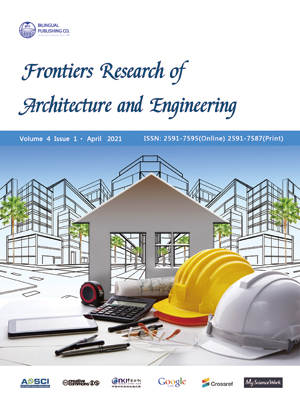Identification of Structural Parameters Based on HHT and NExT
DOI:
https://doi.org/10.30564/frae.v4i1.2746Abstract
Signal processing approaches are widely used in the field of earthquake engineering, especially in the identification of structural modal parameters. Hilbert-Huang Transformation (HHT) is one new signal processing approach, which can be used to identify the modal frequency, damping ratio, mode shape, even the interlayer stiffness of the shear-type structure, incorporating with Natural Excitation Technique (NExT) method to take information from the response records of the structure. The stiffness of the structure is of great importance to judge the loss of its bearing capacity after earthquake. However, all of modal parameters are required to calculate the stiffness of the structure by use of HHT and NExT, which means that the response records shall contain all of modal information. However, it has been found that the responses of the structure recorded only contain the former order modal information; even it is excited by earthquake. Therefore, it is necessary to found a formula (formulas) to calculate the stiffness only using limited modal parameters. In this paper, the calculation formulas of the interlayer stiffness of shear-type structure are derived by using of the flexibility method, which indicate that all of interlayer stiffnesses could be worked out as long as any one set of modal parameters is obtained. After that, Taking Sheraton-Universal Hotel subjected to North Bridge earthquake in 1994 as an example, HHT and NExT are used to identify its modal parameters, the derived formulas are used to calculate the interlayer stiffnesses, and their applicability and accuracy are verified.
Keywords:
Structure, HHT, Natural frequency, Damping ratio, Mode shapeReferences
[1] Liu Zhen, Tang Dai-xin. Research on diagnostic method of damage on building structures[J]. Journal of Harbin University of Civil Engineering and Architecture,2000, 33 (1): 37-40.
[2] Xu Xiu-zhong, Hua Hong-xing, Chen Zhao-neng. Review of Modal Identification Method Based on Ambient Excitation[J]. Journal of Vibration and Shock, 2002,21 (3): 1-6.
[3] N.E.Huang, Z.Shen,S.R. Long, M.L.et al.. The empirical
[4] mode decomposition and Hilbert spectrum for nonlinear and non-stationary time series analysis[J]. Proc. Royal Society of London. A, 1998(454): 903-995.
[5] Yang,J.N, Lei Y. Identification of natural frequencies and damping ratios of linear structure via Hilbert transform and empirical mode decomposition. Proc. of International Conference on Intelligent Systems and control. IASTED/Acta press, Anaheim, CA, 1999:310-315.
[6] James G H,Game T G, Lauffer J P, et al. The nature excitation technique (NExT) for modal parameter extraction from operating structures[J]. Modal Analysis,1995, 10 (4): 260-277.
[7] Li Zhong-fu, Hua Hong-xing, Song Han-wen, Chen Zhi-yan. Modal Parameters Identification of Linear Structures Undergoing Non-Stationary Ambient Excitation[J]. Journal of vibration engineering, 2002, 15 (2): 140-142.
[8] Chen Jun, Xu You-lin. Application of HHT for Modal
[9] Parameter Identification to Civil Structures[J]. Journal of vibration engineering,2003, 16 (3): 383-387.
[10] Li Hong-quan, Ou Jin-ping. Identification and Test Analysis of Earthquake Damage Of Reinforced Concrete Frame Structures[J]. World Earthquake Engineering,1996(4): 37-42.
Downloads
Issue
Article Type
License
Copyright and Licensing
The authors shall retain the copyright of their work but allow the Publisher to publish, copy, distribute, and convey the work.
Frontiers Research of Architecture and Engineering publishes accepted manuscripts under Creative Commons Attribution-NonCommercial 4.0 International License (CC BY-NC 4.0). Authors who submit their papers for publication by Frontiers Research of Architecture and Engineering agree to have the CC BY-NC 4.0 license applied to their work, and that anyone is allowed to reuse the article or part of it free of charge for non-commercial use. As long as you follow the license terms and original source is properly cited, anyone may copy, redistribute the material in any medium or format, remix, transform, and build upon the material.
License Policy for Reuse of Third-Party Materials
If a manuscript submitted to the journal contains the materials which are held in copyright by a third-party, authors are responsible for obtaining permissions from the copyright holder to reuse or republish any previously published figures, illustrations, charts, tables, photographs, and text excerpts, etc. When submitting a manuscript, official written proof of permission must be provided and clearly stated in the cover letter.
The editorial office of the journal has the right to reject/retract articles that reuse third-party materials without permission.
Journal Policies on Data Sharing
We encourage authors to share articles published in our journal to other data platforms, but only if it is noted that it has been published in this journal.




 Yongli Zhang
Yongli Zhang

